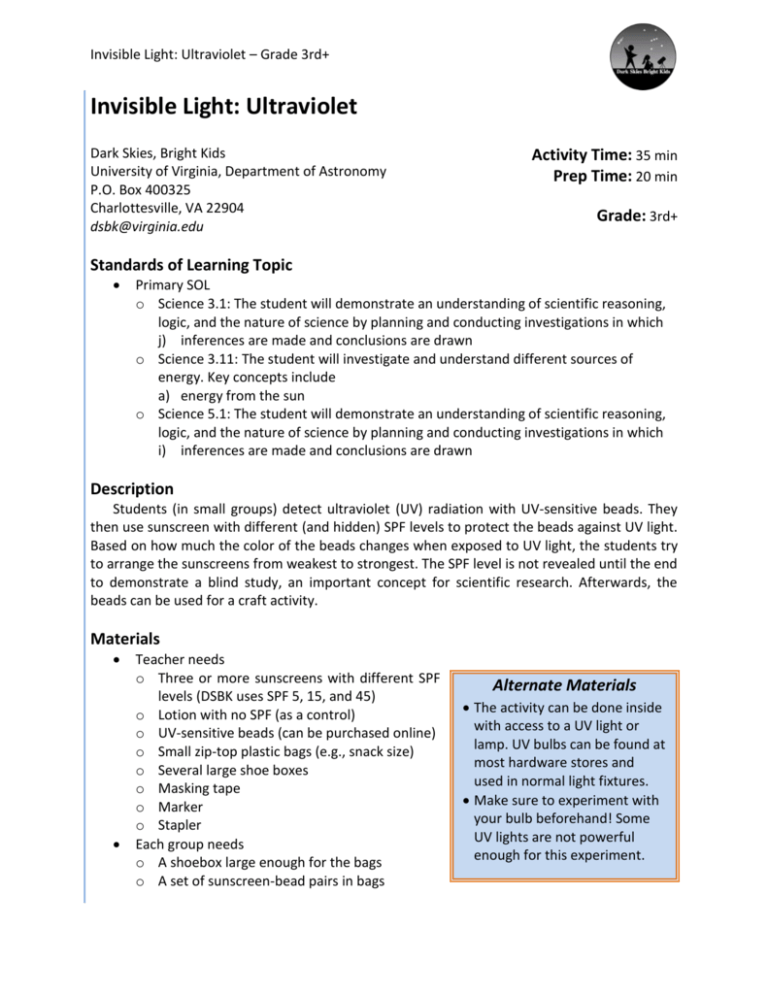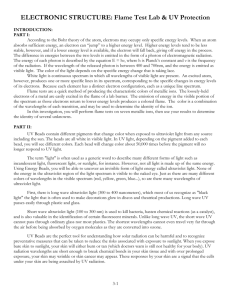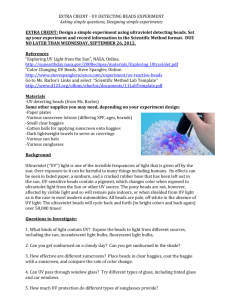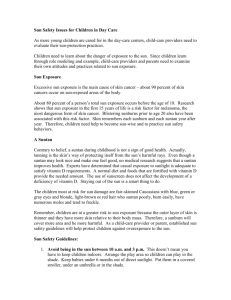Invisible Light: Ultraviolet
advertisement

Invisible Light: Ultraviolet – Grade 3rd+ Invisible Light: Ultraviolet Dark Skies, Bright Kids University of Virginia, Department of Astronomy P.O. Box 400325 Charlottesville, VA 22904 dsbk@virginia.edu Activity Time: 35 min Prep Time: 20 min Grade: 3rd+ Standards of Learning Topic Primary SOL o Science 3.1: The student will demonstrate an understanding of scientific reasoning, logic, and the nature of science by planning and conducting investigations in which j) inferences are made and conclusions are drawn o Science 3.11: The student will investigate and understand different sources of energy. Key concepts include a) energy from the sun o Science 5.1: The student will demonstrate an understanding of scientific reasoning, logic, and the nature of science by planning and conducting investigations in which i) inferences are made and conclusions are drawn Description Students (in small groups) detect ultraviolet (UV) radiation with UV-sensitive beads. They then use sunscreen with different (and hidden) SPF levels to protect the beads against UV light. Based on how much the color of the beads changes when exposed to UV light, the students try to arrange the sunscreens from weakest to strongest. The SPF level is not revealed until the end to demonstrate a blind study, an important concept for scientific research. Afterwards, the beads can be used for a craft activity. Materials Teacher needs o Three or more sunscreens with different SPF levels (DSBK uses SPF 5, 15, and 45) o Lotion with no SPF (as a control) o UV-sensitive beads (can be purchased online) o Small zip-top plastic bags (e.g., snack size) o Several large shoe boxes o Masking tape o Marker o Stapler Each group needs o A shoebox large enough for the bags o A set of sunscreen-bead pairs in bags Alternate Materials The activity can be done inside with access to a UV light or lamp. UV bulbs can be found at most hardware stores and used in normal light fixtures. Make sure to experiment with your bulb beforehand! Some UV lights are not powerful enough for this experiment. Invisible Light: Ultraviolet – Grade 3rd+ Goals Illustrate differences between visible and ultraviolet light Demonstrate the effectiveness of different SPF levels at blocking UV light Demonstrate a blind scientific experiment Introduction to Topic The electromagnetic spectrum contains many types of light, most of which we cannot detect with our eyes. The major regions of the electromagnetic spectrum include: gamma rays, X-rays, ultraviolet, visible, infrared, microwave, and radio. Light can be described by its energy, wavelength, or frequency. Higher energy light has smaller wavelengths and higher frequencies (gamma rays), whereas lower energy light has longer wavelengths and lower frequencies (radio). Pre-Activity Instruction Pro Tips About 80% of UV light can penetrate clouds, so this will work on a cloudy day. The beads can change color about 50,000 times before they no longer work. For a “double blind” study the person leading the activity should not fill the lotion bags so that they will be unaware of the SPF with the students. The sunscreen bags can be used multiple times, though after a large number of experiments the sunscreen will begin to lose its effectiveness. The objective of this activity is to demonstrate that there is light that we cannot see with our eyes but that affects us on a daily basis. The Sun emits light at all wavelengths, from highenergy gamma rays to low energy radio waves. Short wavelength UV rays are harmful to humans and cause sunburns. Sunscreen can protect us from these UV rays, and its degree of protection is known as the sun protection factor (SPF). Discuss with the students what they expect from the different types of sunscreens and how to measure their effectiveness using the beads. Preparation 1) Fill a plastic bag with each sunscreen or lotion to make a thin layer when spread evenly throughout the closed bag. Also, include an empty bag as an example of no sunscreen/lotion. You will make one bag for each sunscreen or lotion for each group. 2) Cover the SPF level on the bottles with masking tape (to conceal it for the experiment). Assign a letter to each bottle and label the bags with their corresponding letter. 3) Make a bag of UV beads for each lotion, sunscreen, and a bag to have no lotion. 4) Staple each sunscreen/lotion bag to a bag of beads above the zip-top so that the bag’s letter is visible. Do the same for an empty bag. Make as many sets as you need. Each group will need a bag of each type. Procedure 1) Demonstrate how the UV beads work by exposing them to UV light. Have the students describe what the beads look like before and after they have been exposed to UV light. Invisible Light: Ultraviolet – Grade 3rd+ 2) Give each group a set of the lotion-bead pairs. Explain that the SPF of each sunscreen is unknown, and they have to rank them from weakest to strongest. Ask them to brainstorm how to determine this using the materials they have. 3) Have each group place their bags lotion side up in a shoebox lid. Cover lid with the main part of the box so that when you are holding the box, it appears upside down. 4) Bring the boxes to the UV light source and open them at the same time. If outside, make sure they are in a sunny spot and make sure the students do not try to look at their beads in the Sun! On a very sunny day, the beads can reach their full color in only a few seconds. 5) Watch the bag with no sunscreen or lotion. When those beads have reached their most intense color, move the boxes away from the UV source and uncover the beads. Have the students rank the sunscreen bags from least to most effective based on the color of each set of beads. Match each bottle of sunscreen to one of the bags. Peel off the masking tape to reveal the SPF for each one. Post-Activity Discussion Does the amount of visible light determine whether you will need sunscreen? Point out that the beads show no change when under indoor lighting, but (if possible) demonstrate that the beads will change color in a cloudy condition (or if sunlight is only partially obscured, by a thin t-shirt or a window). Thus, being able to see one type of light does not mean you will or will not be exposed to a type of light you cannot see. This helps to demonstrate that UV light penetrates cloud cover. To further demonstrate this concept, students can test if windows shield from UV rays. Does this mean you can get a sunburn inside? Similarly, while outside students can cover the UV beads with their own clothing to see whether it is effective at blocking UV light. What types of clothing block UV rays? Can you get a sunburn through your shirt? Does the ordering of sunscreens match your expectations? We found that the ordering was generally correct. It is often difficult to tell the difference between two bags if the SPFs are close in range. You may explain that SPF 15 lets 7% of UV radiation through to skin (when applied perfectly), while SPF 30 allows 4% through, and SPF 60 allows 2%. So the differences are slight even as the numbers get large. Sunscreens with low SPFs are probably difficult to distinguish from your control. Why did we have the labels covered during the experiment? The students determined which sunscreen was the strongest based on the colors of the beads. Had they known which sunscreen had which SPF, their decisions may have been influenced, especially when it was a close call. By covering the labels, the students conducted a blind study, which prevented their results from being prejudiced by prior information. Extensions and Related Activities Invisible Light: Ultraviolet – Grade 3rd+ The beads can be used to make jewelry or keychains. Bring additional beads, strong cord, clasps, earrings, keychain ends, etc. Stations may be helpful for keeping the activity ordered. Have an earring station manned by a volunteer, a bracelet station, a keychain station, etc. A UV lamp or light bulb is useful for this as well so that students can see what their pieces will look like outside! Resources Sunscreen Test: a similar experiment to ours www.stevespanglerscience.com/experiment/uv-reactive-beads The Great Sunscreen Cover Up: all you ever wanted to know about sunscreen www.sciencebasedmedicine.org/?p=5541 The chemistry of UV sensitive beads www.arborsci.com/media/datasheet/P3-6500_DS.pdf Glossary Electromagnetic Spectrum – All the different wavelengths of light, from gamma ray to radio. Sun Protection Factor (SPF) – A measure of the ability of a compound or material to block UV radiation. Visible Light – The wavelengths of light to which our eyes are sensitive. Visible Spectrum – The distribution of colors visible to the human eye seen when light is dispersed by a prism. Ultraviolet (UV) Light – Light whose wavelength is shorter than visible light but longer than X-rays. Wavelength – The distance between two successive points in a wave with the same phase of oscillation.




